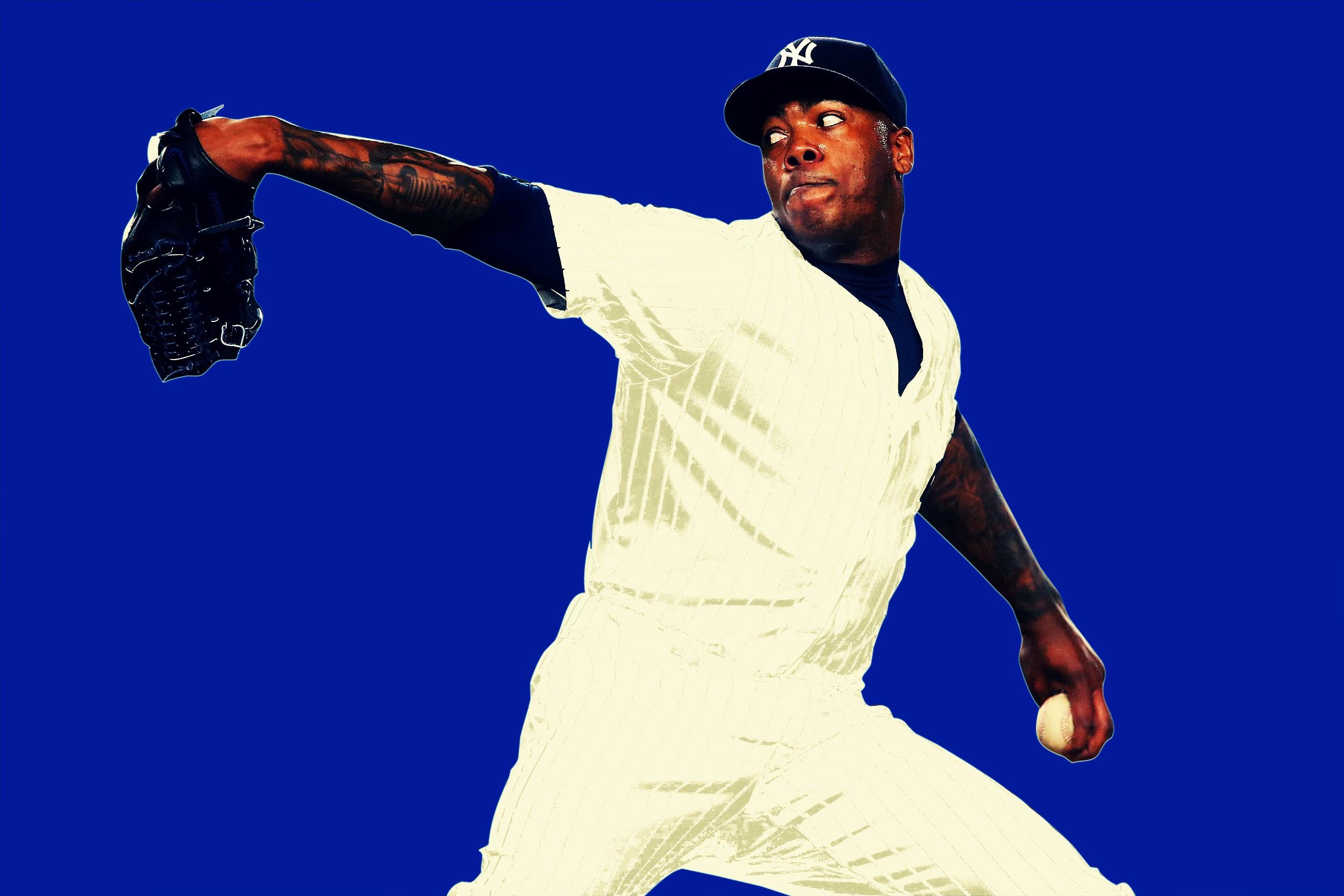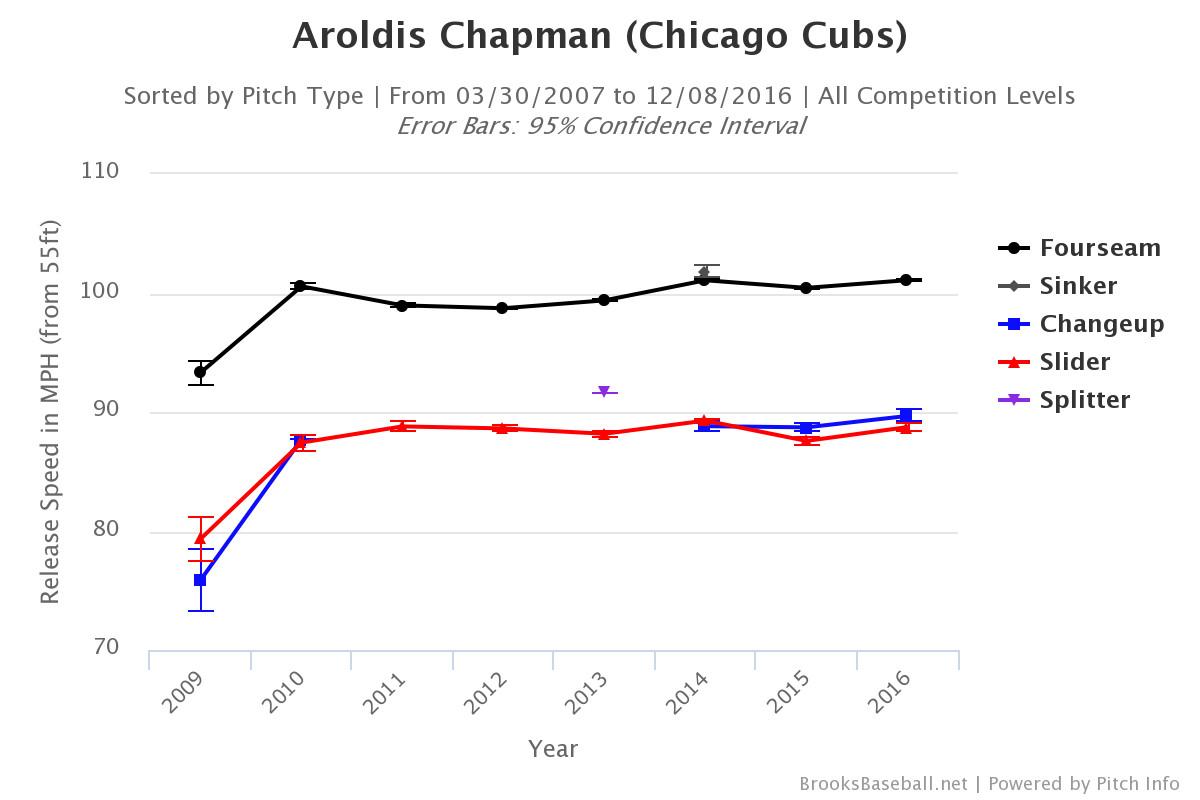
A little more than a day after Yankees GM Brian Cashman tried to portray his team as plucky underdogs to Boston’s free-spending superteam, and a little more than two days after the Giants signed free-agent righty Mark Melancon to a reliever-record four-year, $62 million contract, the Yankees and their once and future closer, Aroldis Chapman, teamed up to overshadow both Cashman’s message and Melancon’s money. On Wednesday night, the Yankees signed Chapman to the new record reliever contract, which guarantees him $86 million over five years.
Like Melancon, Chapman also got some sweeteners. Melancon’s deal includes a full no-trade clause and the ability to opt out after two years, while Chapman’s features a full no-trade clause for the first three years, a limited NTC thereafter, and an opt-out after three years. If all of that sounds exorbitant, well, by historical standards, it is. Both Melancon and Chapman easily exceeded the previous reliever-contract record, four years and $50 million, which was set by Jonathan Papelbon and the Phillies five years ago. Kenley Jansen, who reportedly has his own offer in the vicinity of Chapman’s, will soon blow past Papelbon too. Thanks to Cashman’s profiteering trades — the long-tenured GM picked up Chapman on the cheap from the Reds when the closer was facing a domestic-violence suspension last December, then dealt him to the Cubs at the deadline for a big prospect package after he’d returned to the field — Chapman wasn’t eligible for a qualifying offer and doesn’t cost his new team a compensation pick.
The intrigue here is mostly about money, because we know very well what Chapman looks like on the mound; we even know what he looks like in a Yankees uniform. The only reliever with a higher WAR than Chapman over the past three seasons is Dellin Betances, who’ll go back to being Chapman’s setup man. Chapman is coming off his career-best season by park-adjusted ERA, and he threw his fastball as hard as ever.

If there’s a cause for concern from a performance perspective, it’s that Chapman’s strikeout rate fell to its lowest level since 2011 (while still ranking fifth among all pitchers who threw at least 50 innings). We can pinpoint why that was: Of the 220 pitchers who threw at least 50 major league innings in both 2015 and 2016, Chapman had the second-highest increase in the rate of pitches thrown in the strike zone, trailing only over-the-middle machine Addison Reed. He also had the second-highest increase in the percentage of pitches swung at, behind only James Paxton. If Chapman was trying to pitch to contact — to the extent that a pitcher can while whiffing more than 40 percent of the batters he faces — it didn’t make him more efficient. His rate of pitches per plate appearance was above his career average, although he did post his lowest walk rate yet.
In theory, throwing over the middle more wouldn’t be a bad idea for Chapman, who even relative to other elite pitchers has been extraordinarily hard to hit when he centers pitches. That’s especially true because Chapman gets a bigger boost than most pitchers from being in breaking-ball counts; because he throws his heater so hard and also has such a nasty slider, hitters have an even harder time when they really have to worry about both. But even though he had a higher zone rate in 2016, Chapman didn’t throw first-pitch strikes more often than he has in his other excellent seasons, and he didn’t throw a significantly higher percentage of his pitches while ahead in the count. However we dissect the stats, the conclusion is simple: Chapman is dominant, he’s shown no serious signs of slippage in his stuff or his stats, and he’s not terribly old. (He’ll turn 29 in February.) For now, he’s as likely as any pitcher to give the Yankees a great 60 or so regular-season innings.
Those innings have never before been so expensive, as we started to understand in July, when we saw what Chapman cost the Cubs in prospects. After this year’s reliever-dominated playoffs, Chapman’s windfall was easy to foresee: In November, MLB Trade Rumors’ top 50 free-agent rankings predicted that Chapman would return to the Yankees for five years and $90 million. And it doesn’t seem as if the Yankees’ valuation is out of line with the rest of the league; ESPN’s Jayson Stark reported that Chapman also received a five-year offer from Miami, another rumor claimed that he had an offer of $92 million, and Melancon and Jansen are striking it rich, too.
Pull back a bit, though, and this seems like a lofty commitment: No team has given a free-agent reliever a five-year contract since the Blue Jays blew $47 million on B.J. Ryan more than a decade ago. (Chapman started out angling for an even longer-term deal.) So what changed? A few things, even aside from the fact that this year’s free-agent market for starting-pitchers is barren and the new CBA continues a trend toward capping teams’ spending in non-free-agent areas. Teams have always paid more for relievers than WAR suggests they should, but statheads are increasingly coming around to the idea that their behavior isn’t irrational, and that WAR might be missing something about high-leverage arms.
One thing we know it’s missing: the postseason, which is pretty important. Elite relievers throw a dramatically higher percentage of team innings pitched in the playoffs, and that trend seems to be accelerating. Relievers accounted for a higher percentage of regular-season innings in 2016 than they had in any previous season, and teams doubled down this October with historically quick hooks, led by Terry Francona’s reliance on Andrew Miller and Cody Allen to prop up his ragtag rotation. Maybe teams are to some extent getting caught up in a copycat strategy fueled by the high-profile success of the bullpen-centric Indians and the 2014–15 Royals, but there’s no shame in copying a strategy that makes a lot of sense. In the past, Cashman has opposed spending big money on short relievers, but because of baseball’s ongoing evolution in pitcher usage, particularly in the playoffs, circumstances have changed.
Of course, we won’t know for a while whether the new owners of this winter’s reliever elites will be willing to push them past save situations. Chapman hasn’t seemed as enthused or as effective as some other arms when he’s been asked to do something different, as he was in the World Series, so it’s possible that he’ll still be almost exclusively limited to one-inning outings and deployed in the ninth. (Of Chapman’s 31 outings for the Yankees last year, only two lasted longer than three outs, and only two — both eighth-inning entrances — began before the ninth, although at the time the team also had Miller to shoulder some of the late-inning load.) If Chapman does get locked into save situations, the bright side is that Betances, at least, could go back to looking a little more like the fireman he once was.
The history of relievers with lucrative contracts isn’t reassuring, and if you developed a dislike for Chapman after last year’s news that he is alleged to have attacked his girlfriend and are sorry to see him continue to profit, you probably won’t be pulling for him to be the exception. Even with Chapman, the Yankees probably won’t win a wild card in 2017. By the time the team gets good again, Chapman will have hit 30 and, perhaps, finally lost a little gas. In Jerry Crasnick’s survey of 38 executives, scouts, and managers last month, only six respondents said that Chapman would provide better “value for the contract he’s likely to command” than Jansen or Melancon. (On the other hand, Crasnick’s poll participants haven’t proved very prescient in the past.) There will probably be a point during the life of Chapman’s contract when the Yankees will wish they could void the remainder of the deal. But if that point comes after a deep playoff run that the lefty helped make possible, they won’t regret agreeing to his terms.
An earlier version of this piece incorrectly stated that of Chapman, Jansen, and Melancon, only Chapman wasn’t eligible for a qualifying offer; Melancon wasn’t eligible for a qualifying offer either.

